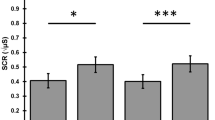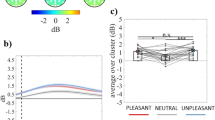Summary
Slow brain potentials, evoked potentials and autonomic responses were investigated in anhedonic subjects and controls. The distribution of physical anhedonia (PA) scores from different samples (students, soldiers, schizophrenics, depressives) is compared. Within a S1–S2 reaction time paradigm, an additional, S2-similar stimulus was introduced during the anticipation interval in 50% of trials (pseudorandom). Subjects had to press the button only to the S2. The additional stimulus (AS) elicits a distinct positive deflection. Anhedonics show larger pre-AS negativity and less reduction in negativity after the S2 (PINV) than controls. The slow wave to S1 as well as the pre-AS negativity vary with the conditional probability of the AS, but to a lesser extent in anhedonics. Anhedonics provide more preparatory negativity prior to and following ambiguous or difficult discrimination tasks, but at the frontal site. Results may suggest impaired contingency evaluation in anhedonic subjects.
Zusammenfassung
Ereigniskorrelierte Potentiale (langsame Potentiale, evozierte Potentiale) und autonome Reaktionen wurden in einem S1–S2-Reaktionszeitparadigma bei Personen erhoben, die auf einer Anhedonieskala hohe oder niedrige (Kontrollgruppe) Werte aufwiesen. Die Verteilung der Anhedoniewerte wurde für verschiedene Gruppen (Studenten, Soldaten, Schizophrene, Depressive) verglichen. Während des sechssekündigen Antizipationsintervalles wurde in 50% der Durchgänge (zufällig) ein dem imperativen Reiz ähnlicher Reiz dargeboten; die Probanden sollten aber nur auf den S2 hin mit Knopfdruck reagieren. Bei Probanden mit hohen Anhedoniewerten zeigt sich gegenüber Kontrollpersonen eine stärkere negative langsame Potentialverschiebung vor dem Zeitpunkt des zusätzlichen Reizes (AS) sowie ein geringerer Rückgang der Negativierung nach dem S2 (PINV). Die Negativierung vor dem AS sowie die ‚'slow wave” auf den S1 variieren mit der bedingten Wahrscheinlichkeit des AS, jedoch weniger deutlich bei Anhedonikern. Der AS selbst löst bei allen Probanden eine positive Verschiebung aus. Die Ergebnisse lassen eine beeinträchtigte Fähigkeit zur Kontingenzermittlung bei Anhedonikern vermuten.
Similar content being viewed by others
References
Abraham P, Docherty TB, Spencer SC, Verhey RH, Lamers TB, Emonds PM, Timsit-Berthier M, Gerono A, Rousseau JC (1980) An international pilot study of CNV in mental illness. In: Kornhuber HH, Deecke L (eds) Motivation, motor and sensory processes of the brain. Electrical potentials, behavior and clinical use. Progress in Brain Research, vol 54. Amsterdam, Elsevier, pp 535–542
Chapman LJ, Chapman JP, Raulin ML (1976) Scales for physical and social anhedonia. J Abnorm Psychol 85:374–382
Chapman LJ, Chapman JP, Raulin ML (1978) Body image aberration in schizophrenia. J Abnorm Psychol 87:399–407
Chapman JL, Edell WS, Chapman JP (1980) Physical anhedonia, perceptual aberration and psychoses proneness. Schizophrenia Bull 6:639–653
Delaunoy J, Gerono A, Rousseau J (1978) Experimental production of postimperative negative variation in normal subjects: In: Otto DA (ed) Multidisciplinary perspectives in eventrelated brain potential research. Washington, U.S. Environmental Protection Agency, pp 355–357
Donchin E (1981) Surprise!...Surprise? Psychophysiology 18:493–513
Dongier M, Dubrovsky B, Engelsmann F (1976) Event-related slow potentials: Recent data on clinical significance. Res Commun Psychol Psychiat and Behav 1:91–104
Dongier M, Dubrovsky B, Engelsmann F (1977) Event-related slow potentials in psychiatry. In: Shagass C, Gershon S, Friedhoff A (eds) Psychopathology and brain dysfunction. New York, Raven Press, pp 339–352
Edell W, Chapman LJ (1979) Anhedonia perceptual aberration, and the Rorschach. J Consult Clin Psychol 47:377–384
Elbert T, Rockstroh B, Lutzenberger W, Birbaumer N (1982) Slow brain potentials after withdrawal of control. Arch Psychiatr Nervenkrank 232:201–204
Gatchel-R, Lang PJ (1973) Accuracy of psychophysical judgement and physiological response amplitude. J Exp Psychol 98:176–183
Giedke H, Bolz J (1980) Pre- and postimperative negative variation (CNV and PINV) under different conditions of controllability in depressed patients and healthy controls: In: Kornhuber HH, Deecke L (eds) Motivation motor and sensory processes of the brain. Electrical potentials, behavior and clinical use. Amsterdam, Elsevier, pp 579–584
Gruzelier JH, Venables PH (1972) Skin conductance orienting activity in heterogenous sample of schizophrenics. J Nerv Ment Disease 155:277–287
Gruzelier JH, Venables PH (1973) Skin conductance responses to tones with and without attentional significance in schizophrenic and non-schizophrenic psychiatric patients. Neuropsychologia 11:211–230
Haberman M, Chapman GH, Numbers JS, McFalls RM (1979) Relation of social competence to scores on two scales of psychosis proneness. J Abnormal Psychol 88:675–677
Hillyard S, Woods D (1979) Electrophysiological analysis of human brain function. In: Gazzaniga M (ed) Handbook of bahavioral neurobiology, vol 2. Plenum Press, New York, pp 345–378
Johnson R, Donchin E (1980) P300 and stimulus categorization: Two plus one is not so different from one plus one. Psychophysiology 17:167–178
Johnson R, Donchin E (1982) Sequential expectancies and decision making in a changing environment: An electrophysiological approach. Psychophysiology 19:183–200
Loveless N (1979) Event-related slow potentials of the brain as expressions of orienting function. In: Kimmel HD, Van Olst EH, Orlebeke JF (eds) The orienting reflex in humans. Erlbaum Pub Ass Hillsdale, pp 77–100
Luria AR (1961) The role of speech in regulation of normal and abnormal behavior. Pergamon Press, Oxford
Luria AR (1973) The working brain. Oxford Penguin Books
Lutzenberger W, Elbert T, Rockstroh B, Birbaumer N, Stegagno L (1981a) Slow cortical potentials in subjects with high or low scores on a questionnaire measuring physical anhedonia and body image distortion. Psychophysiology 18:371–380
Lutzenberger W, Birbaumer N, Rockstroh B, Elbert T (1981b) Physiological responses to reinforcement in subjects with perceptual aberrations. Psychophysiology 18:140
Lutzenberger W, Elbert T, Rockstroh B, Birbaumer N (1981c) Principal component analysis of slow brain potentials during six second anticipation intervals. Biol Psychol 13:271–279
Meehl PE (1962) Schizotaxia, schizotypy, schizophrenia. Am Psychol 17:827–838
Merz F (1982) Zur Problematik des Fragebogen-Screenings auf erhöhtes Schizophrenie-Risiko. Unveröff Diplomarbeit, Tübingen
Miller GA (1981) Doctoral Dissertation, Univ of Madison
Miller GA, Simons RF, Lang PJ (1981) Electrocortical measures of information processing deficit in anhedonia. 6th Int Conference on Event-Related Slow Potentials of The Brain, Lake Forest, Ill
Perris C, Monakhov K (1979) Depressive symptomatology and systematic structural analysis of the EEG. In: Gruzelier J, Flor-Henry P (eds) Hemisphere Asymmetries of Function in Psychopathology. Elsevier, Amsterdam, pp 223–236
Rockstroh B, Elbert T, Lutzenberger W, Birbaumer N (1979) Slow cortical potentials under conditions of uncontrollability. Psychophysiology 16:374–380
Rockstroh B, Elbert T, Birbaumer N, Lutzenberger W (1982) Slow brain potentials and behavior. Baltimore, Urban & Schwarzenberg
Seligman M (1975) Helplessness. San Francisco, Freemann, Witt & Co
Skinner JE, Yingling CD (1977) Central gating mechanisms that regulate event-related potentials and behavior. In: Desmedt J (ed) Attention, voluntary contraction and event-related cerebreal potentials. Karger, Basel, pp 30–69
Simons RF (1981a) Doctoral dissertation, Univ of Madison
Simons RF (1981b) Anhedonia as a risk factor in schizophrenia. Psychophysiology 18:203
Simons RF (1982) Electrodermal and cardiac orienting in psychometrically defined high-risk subjects. Psychiatr Res 4:347–356
Simons RF, MacMillan FW III, Ireland FB (1982) Anticipation in anhedonic subjects: Evidence for a pleasure deficit. Psychophysiology 19:348
Stein L, Wise CD (1971) Possible etiology of schizophrenia: progressive damage to the noradrenergic reward system by 6-hydroxy-dopamine. Science 171:1032
Tecce JJ (1972) Contingent negative variation (CNV) and psychological processes in man. Psychol Bull 77:73–108
Tecce JJ, Savignano-Bowman J, Cole JO (1978) Drug effects on contingent negative variation and eye blinks: The distraction-arousal hypothesis. In: Lipton MA, DiMascio A, Killam KF (eds) Psychopharmacology. Raven Press, New York, pp 745–758
Tecce JJ, Cattanach L (1982) Contingent negative variation. In: Niedermeyer E, Lopes da Silva F (eds) Electroencephalography. Urban & Schwarzenberg, Baltimore, pp 543–562
Venables PH (1975) Psychophysiological studies of schizophrenic pathology. In: Venables PH, Christie MJ (eds) Research in psychophysiology. Wiley, London
Ward PB, Catts SV, Armstrong MS, McConaghy N (1981) P300 and psychiatric vulnerability in university students. 6th Int Conference on Event-Related Slow Potentials of the Brain. Lake Forest, Ill.
Weissman MM, Paykel ED (1974) The depressed woman, a study of social relationships. University of Chicago Press, Chicago and London, pp 236–264
Wise CD, Stein L (1973) Dopamin-β-hydroxylase deficits in the brains of schizophrenic patients. Science 181:344–347
Author information
Authors and Affiliations
Additional information
Research was supported by the Deutsche Forschungsgemeinschaft
Rights and permissions
About this article
Cite this article
Lutzenberger, W., Birbaumer, N., Rockstroh, B. et al. Evaluation of contingencies and conditional probabilities. Arch Psychiatr Nervenkr 233, 471–488 (1983). https://doi.org/10.1007/BF00342787
Received:
Issue Date:
DOI: https://doi.org/10.1007/BF00342787




